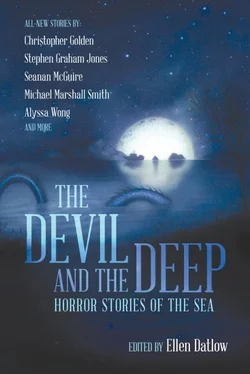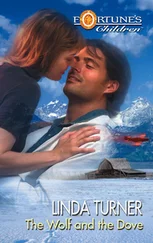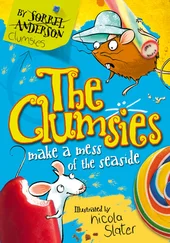The boy’s corpse was swollen. Its swollen limbs still floated every time a wave washed in. In and out.
“There was a ship,” Swift said to himself, trying out the words.
The sun stared down.
Swift waited patiently as the haunt approached. On inspection, he agreed with Mrs. Newman that it might not be a ship at all. The haunt had the general look of a ship—the hull, the masts, the sails—but its cobweb gauziness confused his gaze. He could not figure how such a thing could sail. He supposed he’d soon learn.
The haunt was selective in the corpses it chose. It paused over one body, then took the one beside it, lifting it into the air in a slow arc. One of the corpses it pulled from the rigging fell to pieces, a torn limb splashing into the darkness. The haunt continued its delicate search, serene.
When one of its glowing tendrils passed near him Swift stiffened—some part of him still wanted to live—but then he forced himself to relax. He no longer had the strength to fight it, if he ever had.
The tendril brushed over his shoulder, a prickle of heat and light. It had a dry, horrid smell, like burning bone. The tendril drifted over to the boy, wrapped itself around his torso, lifted him up. Swift’s knots held—he was proud of that—but another tendril arced out of the sky, ripping the rope away. The boy was carried aloft.
The haunt’s light faded, its too-white glare dimming to the muted color of the moon. Its graceful tendrils curled back to the ship like the closing petals of a flower. Slowly, relentlessly, it turned away from the Minerva .
“No,” Swift said. This last outrage was too much. “You don’t get to leave me here. I’m the last one living, aren’t I? The Jonah?” He expected the ship would turn back at the sound of his voice, but the haunt sailed on. It retreated with surprising speed into the darkness.
Cold flooded Swift’s body. They could not leave him here.
“Come back!” The words were hard to force through his parched mouth. He threw himself on his belly, scrabbled forward to the water’s edge, palmed in water to wet his tongue.
“Come back!” His voice was louder now. They’d surely hear him.
Darkness wrapped itself around him. He could not see the haunt at all.
Swift lay alone on the rotting deck, alone in the silent sea. He sometimes thought he heard the dead conversing above him, but he could not make out their words.
He expected them to return, the dead. Surely they’d come back. Decurrs and Glosse, the boy, the women, Bessie, Emily, his little girl as he’d seen her last with the blood cough dribbling down her dress. Or the slaves. No. 23, at least. Or the woman from the waves. Surely they had something to say to him. Some last accusation to make.
But they did not come.
The sun pressed down. The clouds hid the moon.
There passed a weary time.
Something edged into the corner of his vision. A triangle of white. A sail?
Swift lifted his head. A wave of relief filled him. It was the haunt, come to put things right.
But the sail was too solid. He could not see through it. It was, he realized wearily, a living ship.
He watched it pass. There was no reason now to summon it. No one to save.
But the silence pressed down on him, heavy and terrible. An agony of silence.
Swift tried to speak, but his tongue had withered with thirst. No noise came out. It was too far now, to reach the waves that washed the quarterdeck. So he raised his arm to his lips. Bit down. The warm taste of blood freed his tongue. He croaked. Shouted. Wordlessly. A cry from the deep.
The angle of the ship’s sails changed. They’d heard something.
Swift let his head sink down again. He floated on the deck, suspended between life and death, between one possibility and the other.
But he did not think he could die, not yet, not yet. There was a name on his cracked lips. A word like the blood in his mouth. A thing he had to tell.
Author’s Note:
“Years ago, while working at the National Maritime Museum in Greenwich, I came across a sailor’s account of his visit aboard a slave ship. I was struck by the effort he’d made to mobilize his fellow sailors against the slave trade. A few months later I read Marcus Rediker’s magisterial The Slave Ship , which helped put this document into context. In writing “Haunt,” I relied heavily on Rediker’s searing description of the daily operations of slave ships. Readers interested in learning more about sailors’ relationship to the abolition movement should consult this book.
The murders I describe in “Haunt” are all based on real incidents. Of these, the most notorious is the Zong massacre. As James Walvin points out, the mass murder that took place in 1781 became notorious not because the drowning of sick slaves was unusual (it wasn’t), but because British abolitionists made it their first cause célèbre. As with so many slave trade atrocities, we will never know the names of the Africans murdered on the Zong . Given the owners’ destruction of the ship’s logs, we will also never know the names of the ordinary sailors who executed the murders or (according to the first mate’s testimony) of the few who protested the massacre. Nor is it likely we will learn the name of the person who first passed the Zong ’s story on to Olaudah Equiano, the black ‘able seaman’ and anti-slavery activist responsible for turning the massacre into a historical milestone. The victims of the Zong never received justice in a court of law. However, thanks to the efforts of Equiano and other abolitionists, their deaths helped galvanize the popular movement that, decades later, would abolish the transatlantic slave trade. This is not the same as justice. But it has its own meaning.”
ACKNOWLEDGMENT OF COPYRIGHT
Introduction by Ellen Datlow. Copyright © 2018.
Deadwater by Simon Bestwick. Copyright © 2018.
Fodder’s Jig by Lee Thomas. Copyright © 2018.
The Curious Allure of the Sea by Christopher Golden. Copyright © 2018.
The Tryal Attract by Terry Dowling. Copyright © 2018.
The Whalers Song by Ray Cluley. Copyright © 2018.
A Ship of the South Wind by Bradley Denton. Copyright © 2018.
What My Mother Left Me by Alyssa Wong. Copyright © 2018.
Broken Record by Stephen Graham Jones. Copyright © 2018.
Saudade by Steve Rasnic Tem. Copyright © 2018.
A Moment Before Breaking by A. C. Wise. Copyright © 2018.
Sister, Dearest Sister, Let Me Show to You the Sea by Seanan McGuire. Copyright © 2018.
The Deep Sea Swell by John Langan. Copyright © 2018.
He Sings of Salt and Wormwood by Brian Hodge. Copyright © 2018.
Shit Happens by Michael Marshall Smith. Copyright © 2018.
Haunt by Siobhan Carroll. Copyright © 2018.
Simon Bestwickis the author of four story collections, a chapbook, Angels of the Silences , and five novels, most recently Devil’s Highway and The Feast of All Souls . His work has been published in Black Static and Great Jones Street , podcast on Pseudopod and Tales to Terrify , and reprinted in Best Horror of the Year .
A new collection and a new novel, Wolf’s Hill , are both in the works, and his novelette Breakwater is forthcoming from Tor.com. Until recently, his hobbies included avoiding gainful employment, but this ended in failure and he now has a job again. Any and all assistance in escaping this dreadful fate would be most welcome. He lives on the Wirral with his long-suffering wife, the author Cate Gardner, and uses far too many semicolons.
Читать дальше













